Table of Contents
Directions (1-5): Study the information carefully and answer the questions given below.
Eight boxes are placed in a stack one above another. All boxes are of three colours i.e Red, Blue, Green (but not necessary in same order). Not more than three boxes are same colour.
Two boxes are placed between U and S. Three boxes are placed between U and Q, which is green colour box. Only Box R and the box which is placed just above box P are Red colour. Box V is not Green colour. One box is placed between box U and box V, Which is not placed just above or just below box S. One box is placed between box Q and red colour Box. Box Q is not placed just above box S. Box R is placed below box P. Box W is blue colour box which is placed above box U but not just above. Box P is blue colour. Box S is not blue colour. Only one box is placed between W and T, which is not blue colour box. Box Q is placed below box U.
Q1. Which of the following colour box V is?
(a) Red
(b) Blue
(c) Green
(d) Either Red or green
(e) Either Red or Blue
Q2. How many boxes are placed between Box Q and T?
(a) Two
(b) Three
(c) One
(d) Four
(e) None
Q3. Which of the following box is placed just above box R?
(a) P
(b) T
(c) V
(d) S
(e) None of these
Q4. Which of the following combination is true?
(a) V-Green
(b) T-Blue
(c) U-Red
(d) S-Red
(e) None is true
Q5. Which of the following pair of boxes is green colour?
(a) T, Q, V
(b) Q, T, S
(c) S, T ,V
(d) T, U, S
(e) None of these
Directions (6-10): In each of the questions below are given some statements followed by some Conclusions. You have to take the given statements to be true even, if they seem to be at variance from commonly known facts. Read all the conclusions and then decide which of the given conclusions logically follows from the given statements disregarding commonly known facts.
(a) If only conclusion I follows.
(b) If only conclusion II follows.
(c) If either conclusion I or II follows.
(d) If neither conclusion I nor II follows.
(e) If both conclusions I and II follow.
Q6. Statements:
Some cherry are sweet
No sweet is Tomato
All tomato are kiwi
Conclusions:
I: Some kiwi are not sweet
II: All cherry can never be Kiwi
Q7. Statements:
All Dam are steel
Some steel are iron
No pen is steel.
Conclusions:
I: Only steel is Dam
II: Some iron are not Pen
Q8. Statements:
Some place are keyboard
No keyboard is mouse
No place is bottle
Conclusions:
I. All place can never be mouse
II. All mouse can never be bottle
Q9. Statements:
Only king is lion
Some king are tiger
No tiger is duck
Conclusions:
I. All duck are king is possibility
II. Some lion are tiger is a possibility
Q10. Statements:
Only few water is blue
Some blue is red
All red is green
Conclusions:
I. Some green are water
II. No water is green
Directions (11-15): Each of the questions below consists of a question and two statements numbered I and II given below it. You have to decide whether the data provided in the statements are sufficient to answer the question.
(a) If statements I alone is sufficient to answer the question, but statement II alone is not sufficient to answer the question.
(b) If statement II alone is sufficient to answer the question, but statement I alone is not sufficient to answer the question.
(c) If statement either I or II is sufficient to answer the question.
(d) If both the statements I and II taken together are not sufficient to answer the questions.
(e) If both the statements I and II taken together are sufficient to answer the questions.
Q11. What is Sonali’s position from the left end of a row?
I. There are 4 students between Gauri and Sonali. Bhavna is 6th to the right of Gauri.
II. Gini is 6th to the left of Sonali and is 2nd from the left end.
Q12. How many students are sitting between P and Q?
I. P is 5th to the right of R and 6th to the left of S. Q is 6th to the right of R.
II. In a row of 25 students, P is 5th from left end and Q is 20th from the right end.
Q13. Among G, H, I, J and K who among the following got third highest marks?
I. G has got 1 mark less than H and has got more marks than K.
II. I and J have got more marks than G.
Q14. How is N related to Q?
I. C is daughter of Q, who is also the mother of D.
II. B is brother of C and N is the wife of D.
Q15.Who has got highest marks among A, B, C, D and E?
I. D has got greater marks than A and less than C. Also, B has got greater marks than A and less than E.
II. E has got less marks than C and greater than B and D. A has got the lowest marks.
Practice More Questions of Reasoning for Competitive Exams:
Reasoning for Competitive Exams |
Reasoning Ability Quiz For ECGC PO 2021- 26th January |
Reasoning Ability Quiz For ECGC PO 2021- 25th January |
ECGC PO Study Plan 2021 |
Solutions
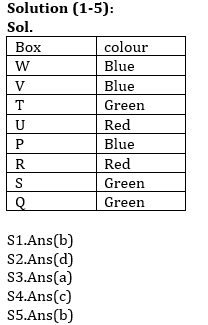
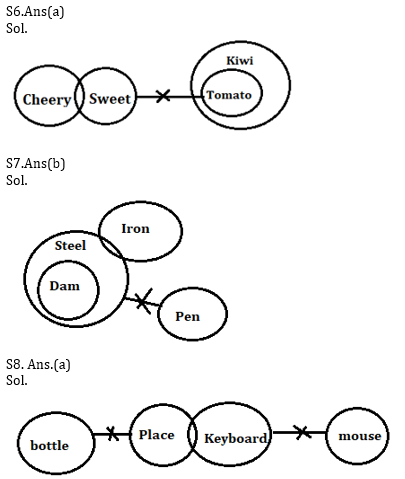
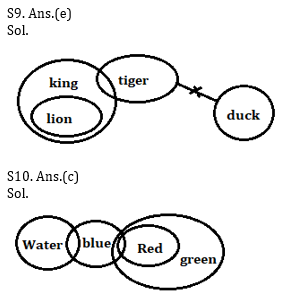
S11. Ans.(b)
Sol. If the data in statement II alone is sufficient to answer the question.
From I: It is given that Gauri is 5th to Sonali but not given left or right
From II: Gini is 2nd from left end, and then Sonali is 6th to right of Gini, so Sonali is 8th from left end.
S12. Ans.(c)
Sol. If the data either in statement I alone or statement II alone are sufficient to answer the question.
From either statement, it says that there is no one between P and Q, or 0 students between P and Q.
S13. Ans.(d)
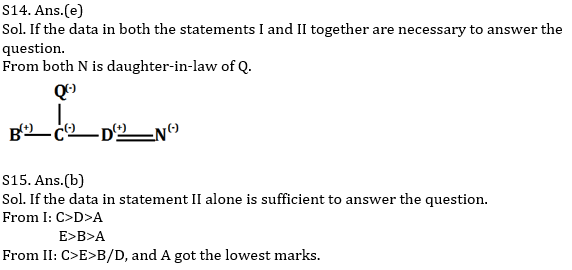
Practice with Crash Course and Online Test Series for ECGC PO 2021:
- ECGC Online Coaching Classes for Probationary Officier 2021
- ECGC PO Mock Tests 2021 – Banking Online Test Series (With Solutions) by Adda247
- ECGC PO 2021 Complete eBooks Kit (English Medium)
Click Here to Register for Bank Exams 2020 Preparation Material

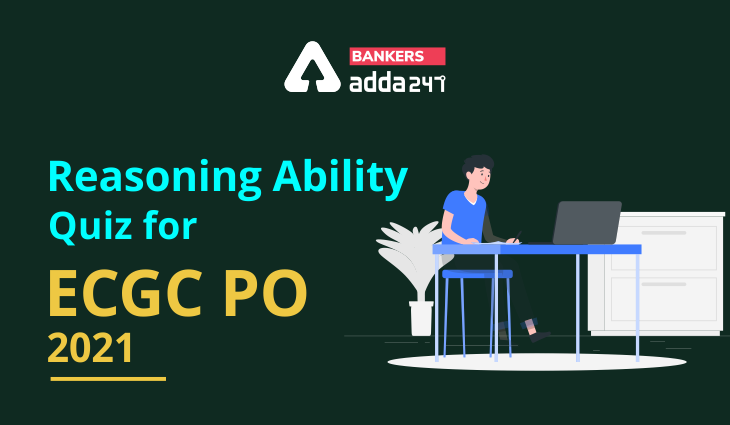


 GA Capsule for SBI Clerk Mains 2025, Dow...
GA Capsule for SBI Clerk Mains 2025, Dow...
 The Hindu Review October 2022: Download ...
The Hindu Review October 2022: Download ...
 Without These Documents, Your Bank Exam ...
Without These Documents, Your Bank Exam ...





